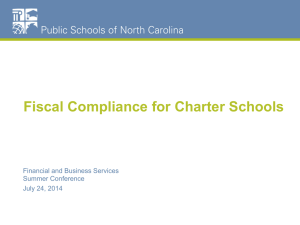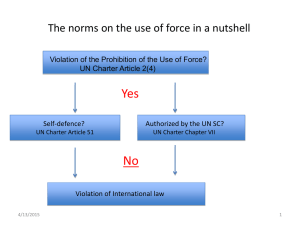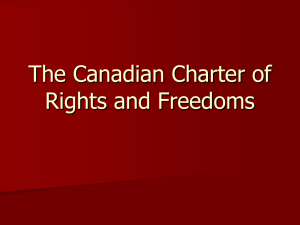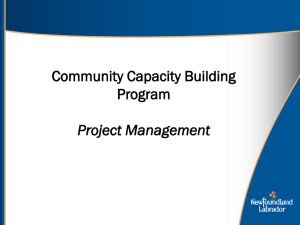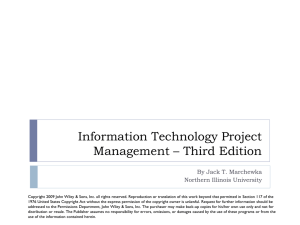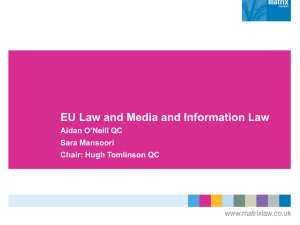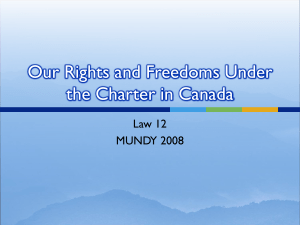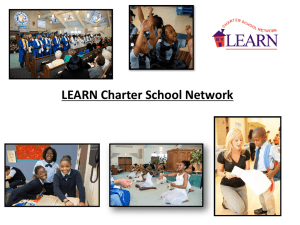Fiscal Compliance - 2014CharterSchoolPlanning
advertisement
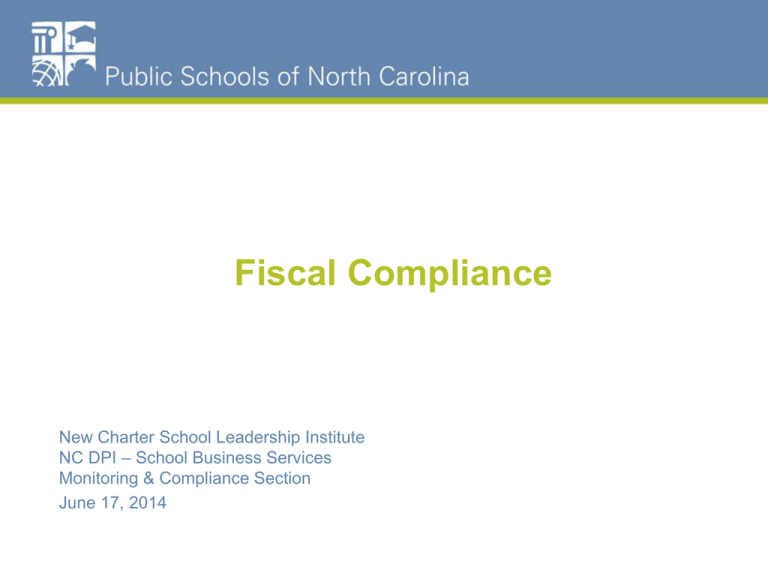
Fiscal Compliance New Charter School Leadership Institute NC DPI – School Business Services Monitoring & Compliance Section June 17, 2014 Monitoring & Compliance Section What is the role of Monitoring & Compliance Section related to charter schools? Provide quality support to charter schools and their stakeholders through timely and accurate oversight and monitoring of charter school grants, programs and related initiatives. Under what authority does Monitoring and & Compliance operate? 34 CFR 80.40 - Grantees (DPI) must monitor grant and subgrant supported activities to assure compliance with applicable Federal requirements. Monitoring & Compliance Section Oversight activities include (but are not limited to) the following: • • • • • • • • • • Fiscal monitoring Indirect Cost Rates 21st Century Community Learning Center grants bond compliance Administrative Cost Limitation compliance Carryover Limitation compliance Audit resolution GS 143C-6-23 compliance DUNS and SAM compliance Technical Assistance Charter School Financial Guide Monitoring & Compliance Section What is fiscal monitoring? What are some examples? Review and analysis of the charter school’s activities to ensure Federal awards are used for authorized purposes in compliance with laws, regulations, and the provisions of contracts or grant agreements. • On-site reviews – – – – Time and Effort Inventory Contracted Services Internal Controls • Desk reviews Fiscal Expectations What is the expectation for fiscal responsibility for charter schools? • Charter schools are required to meet generally accepted standards of fiscal management. (NC Gen. Stat. 115C238.29G(a)(2)). (Handout A) • Charter schools receiving federal funds must comply with applicable statutes, regulations, and approved applications; and must use Federal funds in accordance with those statutes, regulations, and applications. Legislation, Statutes & Guidance • Federal – No Child Left Behind Act of 2001 (NCLB) – Education Department of General Administrative Requirements (EDGAR) – General Education Provisions Act (GEPA) – OMB Circulars • A-133 • A-87 • A-122 • North Carolina General Statute (GS115C-238.29A – GS115C-238.29K) • North Carolina State Board of Education (SBE) Policy Compliance Requirements • • Allowable Costs Budget – – • • • • • • Due by mid-July each year In format specified in grant application DUNS number and SAM registration (Handout B) Conflict of Interest Policy (Handout C) Cash Management Improvement Act (CMIA) Audited Financial Statements Record Retention Contracts – – Inclusion of state language per GS115C238.29H Suspension and debarment (www.pandc.nc.gov/actions.aspx - state and www.sam.gov –federal) • • • • • Administrative Cost Limitations Carryover Limitations Equipment Disposition Documentation (Handout D) – Audit – Monitoring Monitoring – Federal agencies – DPI Monitoring and Compliance Section fiscal monitoring – DPI Program monitors – Office of State Budget and Management (OSBM) – Office of the State Auditor (OSA) Financial Statements North Carolina Education Law requires an annual audit in accordance with: • GS 115C-238.29F(f)(1) The school is subject to the financial audits, the audit procedures, and audit requirements adopted by the State Board of Education for charter schools. These audit requirements may include the requirements of the School Budget and Fiscal Control Act. • Generally Accepted Auditing Standards (GAAS) • Generally Accepted Government Auditing Standards (GAGAS) Financial Statements Responsibilities: • Coordinate audit firm selection process • Contract with selected independent auditor according to standard procurement guidelines • Respond to audit findings and develop and implement corrective action plans to resolve identified issues • Ensure audits are submitted to the Local Government Commission (LGC) by October 31st – LGC will analyze financial data from audit reports, and submitted report approved will forward report to the pass through entity (DPI) – DPI Monitoring & Compliance staff: • Reviews all audits to identify and track findings and corrective action, • Follows up on all proposed responses and corrective action plans to verify implementation Financial Statements (continued) Financial Statement Red Flags: • Low or negative cash balance • Accounts receivable remain constant throughout year without decrease • Payroll tax liabilities constant or increase • Failure to pay health insurance and/or employee retirement plan payments • Current & Long Term Debt excessively high • Fund Balance decline or negative • Operating expenses higher than budget • Student count decline Financial Statements (continued) Charter School Financial Performance Framework Includes: – Charter School Financial Performance Framework Guide – Charter School Ratio Analysis – Charter School Financial Summary Financial Statements (continued) Financial Performance Framework Uses: • • • • Intervention Renewal Revocation General Monitoring Financial Statements (continued) Component Definition Example Indicators General categories of financial performance Near Term Measures General means to evaluate an aspect of an indicator Current Ratio Metrics Method of quantifying a measure Current ratio is the school’s current liabilities over current assets Targets Thresholds that signify success in meeting the standard for a specific measure Current ratio greater than 1.1 Ratings Assignment of charter school performance into one of three rating categories, based on how the school performs against the framework targets If school meets the target of 1.1 the rating category is “Meets Standard” Financial Statements (concluded) Most Common Audit Findings • Absence of Conflict of Interest Policy • Absence of Required Language on Contracts – No indebtedness of any kind shall constitute an indebtedness of the State or its political subdivisions, and no indebtedness of the charter school shall involve or be secured by the faith, credit, or taxing power of the State or its political subdivisions. • Internal Control Deficiencies – – – – – Segregation of Duties* Procurement - suspension and debarment Review and signoff Claims in excess of eligible cost Costs claimed lacked supporting documentation Financial Noncompliance • G.S.115C-238.29G - Causes for nonrenewal or termination include “failure to meet generally accepted standards of fiscal management” • SBE Policy TCS-U-006 - further defines the “standards of fiscal management” under which a charter school is held accountable. Financial Noncompliance (continued) What are three stages of noncompliance for charter schools? • LEVEL 1 = Cautionary Stage (30days) Minimal level warning to encourage immediate compliance. • LEVEL 2 = Probationary Stage (30days) State funds may be allotted on a monthly basis. • LEVEL 3 = Disciplinary Stage (10 days) 10 days to respond to noncompliance issues. Last step before recommendation revocation of charter. Financial Noncompliance (concluded) Financial Noncompliance: • • • • • Failure to respond to requests for data (UERS or other). Showing signs of financial insolvency or weakness. Having material audit findings which remain unresolved. Receiving NSF notifications from the State Treasurer’s office. Having a declining student count Monitoring & Compliance Section Contact Information • Leigh Ann Kerr, Assistant Director, School Business Services; LeighAnn.Kerr@dpi.nc.nc.gov ; (919)807-3553 • Curtis Terry, Fiscal Analyst; Curtis.Terry@dpi.nc.gov ; (919)807-3720 • Keisha Davis, Fiscal Monitor; LaKeisha.HallDavis@dpi.nc.gov ; (919)807-3682 • Karen Frazier, Fiscal Monitor; Karen.Frazier@dpi.nc.gov ; (919)807-3738 • Gene Bruton, Accountant (Single Audit, DUNS/SAM, Certification); Gene.Bruton@dpi.nc.gov ; (919)807-3726 Resources • NC Department of Public Instruction Financial and Business Services – http:www.ncpublicschools.org/fbs • US Department of Education Guidance – http://www2.ed.gov/policy/landing.jhtml • Office of Budget and Management – OMB Circular A-87, Attachment B – OMB Circular A-133 • OMB Circulars/Cost Principles – http://www.ncpublicschools.org/fbs/finance/federal/
